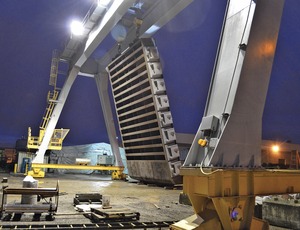

The first massive gate for the Folsom Dam Auxiliary Spillway project arrived last month at Folsom, Calif.—about 20 miles east of Sacramento—after a four day, 600-mile journey. Carrying a bulkhead gate so large it took up two lanes of traffic to allow its passage, a 100-ft-long flatbed rolled onto the jobsite in the middle of the night on March 14 with a California Highway Patrol escort.
The gate's odyssey from Oregon Iron Works in Vancouver, Wash., where it was fabricated, will be repeated 17 more times to transport the dozen gates to the dam location above Sacramento. That's not counting the trips needed to move additional, smaller gate parts.
The $45-million gates are a key element of the $900-million spillway project, designed to protect California's capital from inundation. The 3,027-ft-long spillway is designed to channel flows from the Folsom Lake through a stilling basin, which will reduce its speed approaching the American River.
The spillway project is being built by the Folsom Joint Federal Project, a cooperative effort between the U.S. Army Corps of Engineers and the U.S. Dept. of the Interior, Bureau of Reclamation. Work began in 2008 and is slated for completion in 2017.
Granite Construction Co. is handling the $125.9-million gate-control-structure portion of the job, which should complete next year. The company evaluated myriad transportation scenarios for the gates, including using barges and air transport, before settling on driving each one down individually from Washington.
"It would have been more of a cost advantage if all the bulkheads could be shipped at the same time on the same barge, but the fabrication and installation schedule precluded this," says Tom Peick, the project manager from Granite Construction.
Since all the gate components are significantly wider than the roadways they must traverse to reach their new home, transporting them involves a formidable logistical challenge. The moving operation requires a rolling closure of the southbound lanes of Interstate 5 and, through Sacramento itself, similar closures of thoroughfares.
The six flat, panel-shaped bulkhead gates are being shipped completely assembled. The curved Tainter gates will be transported in two parts: the framework arm and the facing. When assembled, the Tainter gates, 45-ft, 3-in. on the face and 28-ft, 9-in. wide, pivot—open or closed—in an arc via the arm.
Corps' Sacrament District officials say installation of the first Tainter gate will begin in May. For each 179-ton gate, the process is expected to take four months, they say. First, the gate support structure must be installed, a time-consuming process due to the high precision required. Then, the parts will be lowered 110 ft to their final position within the confined conduit walls.
The 23-ft, 9-in.-long, 39-ft-tall and 3-ft, 6-in.-wide bulkhead gates, each weighing 106.4 tons, will begin being put into place in August and require as much as three weeks to install. To install the bulkhead gates, roller assemblies—eight per side—will be attached to each gate; then, each gate will be hoisted into a vertical posture and positioned over the control structure by crane, says Jacqueline Steiner, engineer with JFP.
"[The gate] will slowly be lowered into the bulkhead-gate slot through the head wall until the bottom seal is resting on the sill beam," she says.
According to Corps officials, the concrete work for the control structure itself is about 90% complete and should be finished by summer. At that point, work will shift to the electro-mechanical phase, which includes the gate installation, continuing into next year.



Post a comment to this article
Report Abusive Comment